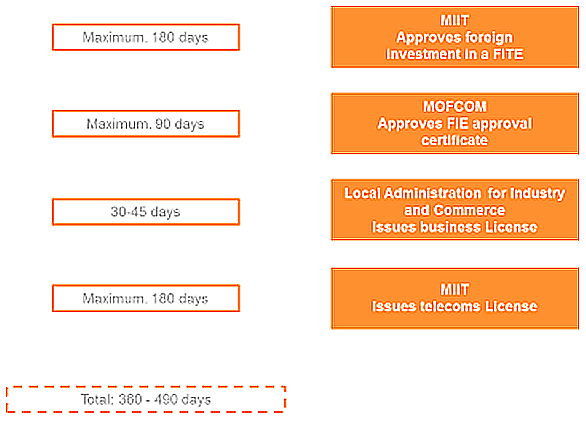Regulation of Telecommunications Sector in China: Overview
Regulation of Telecommunications Sector in China: Overview
by Yang Zhou, Zhong Lun Law Firm and Practical Law China
The content of this practice note was originally appeared on Practical Law China with the title of "Regulation of telecommunications sector in China: overview" and is republished with permission by Thomson Reuters.
Practice note: overview | Maintained | China
Regulatory framework for telecoms sector
Foreign investment catalogue classification
Preferential policies for foreign investment in telecoms
Distinction between BTS and VATS
Specific BTS services regulated as VATS
Classification of telecoms services
Summary of changes to telecoms classifications in 2015 Telecoms Catalogue
What telecoms licence does an operator need?
Validity period of a telecoms licence
Annual report and random inspection
Qualification requirements for telecoms licences
Approving authority and approval timeline
Operation and registration of services in other provinces
Continuing obligations of operators
Regulatory framework for foreign investment in telecoms
Equity restrictions under domestic legal regime
Capitalisation and Qualification requirements
Key steps in the approval process for a FITE
Approval for establishment of a FITE: diagram
Exceptions to foreign shareholding cap
E-commerce business open to 100% foreign ownership
Relaxation of policies for offshore call centre services
Preferential policies under CEPAs
Preferential policies in Shanghai FTZ
Variable interest entities (VIE) structure
An overview of the regulatory regime governing the telecommunications sector in China and the regulation of foreign investment in this sector. This note also provides an overview of the corresponding preferential policies that apply in certain special investment zones (such as the Shanghai FTZ) and under CEPA between China and each of the Hong Kong or Macau Special Administrative Region.
Scope of this note
This note describes the regulations governing the telecoms sector in China and the permitted structures for foreign investment in this sector. (For more information on the regulations of internet content services under the telecoms sector, see Practice note, Regulation of internet content services in China.)
This note also provides an overview of the corresponding preferential policies that apply in certain special investment zones (such as the China (Shanghai) Pilot Free Trade Zone (Shanghai FTZ)) and under the Closer Economic Partnership Arrangements (CEPA) between China and the Hong Kong or Macau Special Administrative Regions.
Regulatory framework for telecoms sector
The principal statute governing the operation of telecoms services in China is the Telecommunications Regulations of the People’s Republic of China 2000 (2000 Telecoms Regulations).
The 2000 Telecoms Regulations are supplemented by a large body of subordinate legislation covering a broad range of matters, including:
- Licences.
- Fee collection.
- Interconnectivity.
- Operation of specific types of telecoms services, such as internet news information, internet publishing and internet audio-visual programmes.
- Regulation of specific types of investors, such as foreign investors, Hong Kong or Macau investors or domestic Chinese investors.
The most important subordinate legislation for foreign investors in this sector includes:
- Circular of the Ministry of Industry and Information Technology on issuing the "Classified Catalogue of Telecommunications Services" 2015 (2015 Telecoms Catalogue). This catalogue lists out what is classified as a basic telecoms service (BTS) and what is classified as a value-added telecoms service (VATS) (see Distinction between BTS and VATS). This classification affects the licensing and administration of a particular service (see Telecoms licensing).
- Measures for the Administration of Telecommunication Business Operation Licence 2017 (电信业务经营许可管理办法) (2017 Telecoms Licensing Measures) (effective on 1 September 2017). These detail the requirements that all operators must satisfy to obtain a licence to operate telecoms services in China.
- Provisions on the Administration of Foreign-Invested Telecom Enterprises 2008 (2008 Foreign-Invested Telecoms Regulations). These detail the additional requirements that a foreign-invested operator and its foreign shareholders must satisfy to obtain a licence to operate telecoms services in China. A foreign-invested operator of telecoms services is called a foreign-invested telecoms enterprise (FITE).
Foreign investment catalogue classification
The Catalogue of Industries for Guiding Foreign Investment (2017 Revision) (2017 Foreign Investment Catalogue) (effective on 28 July 2017) restricts foreign investment in the telecoms services sector. This bears the following implications:
- Business scope limitations. Not all telecoms services are open to foreign investment. Foreign investment is only permitted in certain types of telecoms services. (For further details, see Regulatory framework for foreign investment in telecoms.)
- Government approvals. In addition to industry approvals from the telecoms regulators (see Regulators) (which apply equally to both foreign and domestic investors), foreign investors will be required to obtain approvals from the Ministry of Commerce (MOFCOM) or its counterparts at the provincial level to set up FITEs. If any foreign investment fixed assets projects are involved, project approvals from the National Development and Reform Commission of China (NDRC) or its local counterparts will also be required. The level of scrutiny required depends on the total investment amount (see Practice note, Establishing a China business: Project approvals and Central or local MOFCOM approval?).
- Minimum domestic shareholding. With limited exceptions, foreign investment in the telecoms sector is subject to a minimum domestic shareholding requirement of 51% for BTS and 50% for VATS. That is, the investment vehicle must be a Sino-foreign equity joint venture company (EJV) and the foreign shareholding ratio in the EJV is capped at 49% for BTS and 50% for VATS. These foreign shareholding caps can be exempted in some circumstances, including, for certain types of telecoms services (for example, operating for-profit e-commerce platforms (经营类电子商务)), or for businesses in selected pilot areas, or for Hong Kong or Macau service providers. For more information on the available exceptions, see Exceptions to foreign shareholding cap.
The foreign investment catalogue is a reflection of China’s investment priorities and is regularly updated to reflect changes in these priorities. The NDRC and MOFCOM jointly released the 2017 Foreign Investment Catalogue to replace the previous 2015 version.
The new catalogue explicitly requires the scope of the telecoms services open to foreign investment to be limited to the types of business liberalised according to the WTO commitments. In practice, most of those services have never been accessible to foreign investors. (For more information, see WTO commitments.)
For more information on the implications of the key changes of the 2017 Foreign Investment Catalogue, see Article, 2017 foreign investment catalogue: the debut of nationwide negative list in China.
For more information on the overall framework governing foreign direct investment in China, see Practice note, Chinese foreign direct investment law: overview.
Preferential policies for foreign investment in telecoms
Certain preferential policies are available to foreign investors. These are not generally applicable to all investors throughout China but are made available in pilot areas or to Hong Kong or Macau service providers.
- Preferential policies in free trade zones. China periodically designates territories as free trade zones (FTZs) to trial experimental policies, such as the Shanghai FTZ (see Preferential policies in Shanghai FTZ).
- Preferential policies for CEPA investors. Investors from Hong Kong or Macau under CEPA arrangements receive a number of preferential benefits (see Preferential policies under CEPAs).
Regulators
The administrative control over telecoms is organised along the usual lines of China’s hierarchical government structure. A national administrator is in charge of national policy while local government offices have responsibilities in the areas of local implementation and enforcement.
The national regulator is the Ministry of Industry and Information Technology (MIIT), which has a very wide jurisdiction that extends beyond telecoms services and includes (amongst others) the regulation of industry standards in the internet technology sector. In the telecoms area, it is responsible for:
- Formulating national regulations.
- Formulating standards and policies.
- Issuing telecoms licences to operators seeking to carry out business nationwide and foreign-invested telecoms operators.
The telecoms administration bureau of provinces, autonomous regions and municipalities directly under the MIIT are referred to as the Local Communications Bureau. These are in charge of administrating telecoms services within their jurisdictions as well as the initial review of applications to operate nationwide.
Distinction between BTS and VATS
China follows international practice by classifying telecoms services into BTS and VATS. The definitions and principles of the classification of both types of services are set out in the 2000 Telecoms Regulations. The classification of a service into one of the two categories affects the administration of the service (see Telecoms licensing).
Definitions for BTS and VATS
BTS and VATS are defined as follows:
- BTS means the business of providing public network infrastructure, public data transmission and basic voice communications services.
- VATS means the business of providing telecoms and information services through the use of public network infrastructures.
(Article 8, 2000 Telecoms Regulations.)
These definitions are in line with international practice.
Each of BTS and VATS is further divided into a Category 1 and a Category 2 under the 2015 Telecoms Catalogue (see Classification of telecoms services). Category 1 services are regulated more heavily than Category 2 services. The basis for the distinction is that services falling into Category 1 generally have more economical or social impact than those under Category 2. As a result, the Chinese government in practice adopts a more lenient policy towards the participation of private or foreign capital in Category 2 services than in Category 1 services.
Specific BTS services regulated as VATS
Under the 2015 Telecoms Catalogue, the following BTS (that is, the bulk of BTS Category 2) are regulated as if they were VATS when determining qualification requirements and approval procedures:
- Wireless paging services (无线寻呼业务).
- Domestic very small aperture terminal (VSAT) earth station communication services (国内甚小口径终端地球站通信业务).
- Fixed network domestic data transmission services (固定网国内数据传送业务).
- Customer premise network (CPN) access services (用户驻地网业务).
- Network hosting services (网络托管业务).
In addition, where a BTS provides cellular mobile communications services (蜂窝移动通信业务) (BTS Category 1) through resale, it is also administered by reference to VATS. The resale of the communications services is where a reseller purchases cellular mobile communications services from a BTS provider who owns a mobile network, then repackages the services under its own brand and sells the services to the end users. This change is in line with the pilot policy initiated by the Notice of the Ministry of Industry and Information Technology on Conducting Pilot Program for Mobile Communications Resale Business 2013 (工业和信息化部关于开展移动通信转售业务试点工作的通告).
|
Classification of telecoms services The following table provides the detailed classification of telecoms services in China contained in the 2015 Telecoms Catalogue.
|
Summary of changes to telecoms classifications in 2015 Telecoms Catalogue
The 2015 Telecoms Catalogue replaced the 2003 edition of the catalogue and superseded a draft revision circulated in 2013.
The 2015 Telecoms Catalogue captures the following new types of telecoms services:
- For BTS:
- LTE/4G digital cellular mobile communications services (LTE/第四代数字蜂窝移动通信业务) (BTS Category 1);
- wired network access facilities services (有线接入设施服务业务) (BTS Category 2); and
- satellite-based fixed communications services (卫星固定通信业务) (BTS Category 1).
- For VTAS:
- internet resource collaboration businesses (互联网资源协作服务业务) (VATS Category 1);
- content delivery or distribution network (CDN) businesses (内容分发网络业务) (VATS Category 1);
- offshore call-center businesses (离岸呼叫中心业务) (VATS Category 2); and
- code and protocol conversion businesses (编码和规程转换业务) (VATS Category 2).
(Classes A1, A2, B1 and B2, 2015 Telecoms Catalogue.)
Historically, the broadest classification under VATS Category 2 was information services classification. The 2003 version of the telecoms catalogue defined "information services" as information services directly provided for end users by information gathering, development, processing and the construction of information platforms, including mainly content services, entertainment or games, commercial information and positioning information services.
The 2015 Telecoms Catalogue does not mention these specific services, but it retains the basic elements of the definition and specifically includes each of the following:
- Information publishing platform and delivery services.
- Information search services (that is, search engines).
- Information community platform services.
- Instant information exchanges.
- Information security and processing services.
For a more detailed explanation of the changes to the telecoms classifications in the 2015 Telecoms Catalogue, see Legal update, MIIT releases 2015 Telecoms Catalogue.
Telecoms licensing
Every operator of telecoms services in China must obtain a licence to operate telecoms services from the relevant telecoms authority (that is, the MIIT or the relevant Local Communications Bureau) (Article 7, 2000 Telecoms Regulations). The telecoms authority in charge of issuing the telecoms licence depends on:
- The classification of the service.
- Its regional scope of operation of the service.
- Whether or not foreign investment is involved.
For more information, see Approving authority and approval timeline.
In response to the company reforms on simplifying administrative approval and commercial registration systems, the MIIT has established an online telecom business administration platform (Online Platform) to support the online telecoms licence application, approval and administration, as well as information publication and inquiry (Article 3, 2017 Telecoms Licensing Measures). The 2017 measures also remove the requirements of submitting capital verification reports and name pre-verification certificates when applying for telecoms licences (see Qualification requirements for telecoms licences). (For more information on the company reforms, see Practice note, Understanding the 2013 Company Law reforms: China.)
Telecoms licences are granted for a limited scope of operation. The holder of a telecoms licence is only permitted to carry out the activities specified in the licence (Article 16, 2017 Telecoms Licensing Measures). (For more information on the principal obligations of a telecoms licence holder, see Continuing obligations of operators.)
What telecoms licence does an operator need?
A telecoms operator must obtain the right licence for the type of service that it is seeking to provide. There are two types of telecoms licence:
- Telecoms licence for BTS (BTS licence).
- Telecoms licence for VATS (VATS licence).
(Article 9, 2000 Telecoms Regulations.)
VATS licences are further classified as:
- Single province. A licence to provide VATS within a single province-level administrative division of China (such as a province, municipality or autonomous region) under the relevant Local Communication Bureau.
- Cross-provincial. A licence to provide services nationwide issued by the MIIT.
The capitalisation and qualitative requirements to obtain a single-province licence are less onerous than those required to obtain a cross-provincial licence.
Services that are provided entirely over the internet, such as internet content services, do not involve any physical crossing of provincial borders. As a result, it is normal for operators of online services to apply for a single province VATS licence as the requirements are less onerous. (For more information on the licensing requirements of specific internet content services, see Practice note, Regulation of internet content services in China.)
Validity period of a telecoms licence
Under Article 14 of the 2017 Telecoms Licensing Measures, a VATS licence is valid for five years and a BTS licence is valid for five or ten years, depending on the classification of telecoms services.
A telecoms licence can be renewed at the end of its term. The holder of a telecoms licence is required to submit a renew application within 90 days before the expiry of its term. If the holder of a telecoms license does not operate telecoms business during the validity period, such holder will not be entitled to renew its telecoms license. (Article 27, 2017 Telecoms Licensing Measures.)
Annual report and random inspection
In the first quarter of each year, telecoms licence holders must submit their annual operation information (such as the last year performance, network construction, business development, execution of their network and information security safeguard mechanism and so on) to the MIIT or the relevant Local Communications Bureau through the Online Platform. The authorities will perform a random inspection on selected telecoms operators (Articles 35-36, 2017 Telecoms Licensing Measures).
According to the inspection result and penalty records, the MIIT or Local Communications Bureau may include the entities violating the telecoms regulatory requirements into the following lists, which are publicly available through the Online Platform (Article 37, 2017 Telecoms Licensing Measures):
|
Telecoms business operation abnormal list (电信业务经营不良名单)
|
Telecoms business operation dishonest list (电信业务经营失信名单)
|
|
|
The key implications for being caught within the two lists include:
- An operator on the lists will be under increased supervision by the MIIT or Local Communications Bureau.
- Where the operator is included in the telecoms business operation dishonest list, its principal management personnel will also be included in the list, meaning that they cannot act as the management team to set up another telecoms business (see Qualitative requirements).
- It will have a negative impact on the operator’s co-operation with BTS operators and VATS operators providing network access services.
(Article 42(4) and 43, 2017 Telecoms Licensing Measures.)
Qualification requirements for telecoms licences
The 2017 Telecoms Licensing Measures set out the requirements and procedure for obtaining a telecoms licence in China. Some of these rules on licensing of VATS were relaxed in the Shanghai FTZ (see Preferential policies in Shanghai FTZ). The requirements include both quantitative (minimum capitalization) and qualitative elements.
In addition to these requirements, domestic Chinese and foreign investors in a FITE must also meet certain criteria (see Capitalisation and qualification requirements).
Capitalisation requirements
The following table details the minimum registered capital requirements for operators of telecoms services (Articles 5-6, 2017 Telecoms Licensing Measures):
|
Scope of operations
|
BTS
|
VATS
|
|
Single province
|
RMB100 million
|
RMB1 million
|
|
Cross-provincial (nationwide)
|
RMB1 billion
|
RMB10 million
|
Qualitative requirements
An operator applying for a BTS licence or VATS licence must satisfy qualitative conditions (Articles 5-6, 2017 Telecoms Licensing Measures).
|
Type of operators
|
Qualitative conditions
|
|
BTS operators
|
|
|
VATS operators
|
Additional requirements apply to VATS operators under the Notice of the Ministry of Information Industry on Strengthening the Administration over Foreign Investment in the Operation of Value-Added Telecom Service 2006, where the internet domain names and registered trade marks used by a VATS operator must be lawfully registered under the name of the VATS operator or its shareholders. This is to prevent foreign-invested operators from evading the government approval requirements by authorising a domestic operator that holds a VATS licence to use the foreign operator’s internet domain authorisation or registered trademark.
|
Approving authority and approval timeline
The following table details the telecoms authorities that must examine and approve applications for a telecoms licence. It also outlines the timescale for these applications (Articles 9-11, 2017 Telecoms Licensing Measures). If experts are involved in the review process (only mandatory for a BTS licence application), the approval timeline below does not count the expert review time (Article 12, 2017 Telecoms Licensing Measures).
|
Type of telecoms licence
|
Approving authority
|
Approval timeline (in calendar days)
|
|
BTS licence
|
MIIT
|
180 days
|
|
Single province VATS licence
|
Local Communications Bureau
|
60 days
|
|
Cross provincial (nationwide) VATS licence
|
MIIT
|
60 days
|
Operation and registration of services in other provinces
A BTS operator or cross-provincial VATS operator, after obtaining the relevant telecoms license, is no longer required to go through the filing formalities with the Local Communications Bureau of the area where the operator operates its telecoms business under the 2017 Telecoms Licensing Measures.
A cross-provincial telecoms operator should report the establishment, amendment or cancellation of branches to the original licence issuing authorities and Local Communications Bureau of the relevant provinces through the Online Platform within 30 days after the decision (Article 39, 2017 Telecoms Licensing Measures).
A cross-provincial BTS operator must not authorise more than one affiliate in the same geographic area to operate the same category of BTS (Article 18, 2017 Telecoms Licensing Measures).
Continuing obligations of operators
A telecoms operator must display its telecoms licence number in a prominent place including the company’s principal business premises, website main page and business promotion materials (Article 16, 2017 Telecoms Licensing Measures). In addition, a telecoms operator must respectively establish organisations and appoint full-time personnel for network and information security management, and establish relevant network and information security and monitoring systems with the corresponding technical safeguard measures (Article 26, 2017 Telecoms Licensing Measures).
The 2017 measures also specify general operational requirements that BTS and VATS operators must comply with.
|
Type of operators
|
Continuing obligations
|
|
BTS operators
|
(Articles 20 and 22-23.)
|
|
VATS operators
|
(Article 24.)
|
Telecoms operators must also satisfy the following compliance requirements:
- Confidentiality. This includes confidentiality of trade secrets, state secrets and personal information. (For further information, see Practice notes, State secrets, trade secrets and confidentiality: China and Data privacy in China.
- Anti-terrorism Law. The Anti-terrorism Law of the People’s Republic of China 2015 (2015 Anti-terrorism Law) imposes significant obligations on businesses that operate in the telecoms and internet sectors, including:
- providing technical interface and decryption information to the government during a lawful counterterror investigation;
- developing content monitoring and network security programs;
- preventing the dissemination of information on "extremism" (a term the law does not define) and reporting, preserving for government use, and deleting from public circulation information on terrorist activities; and
- verifying the identities of customers.
- For further information on the 2015 Anti-terrorism Law, see Legal update, NPC enacts anti-terrorism law.
- Cybersecurity Law. The Cybersecurity Law of the People’s Republic of China 2016 (2016 Cybersecurity Law) requires network operators in telecoms sectors to comply with a series of regulatory obligations, including (amongst others):
- performing the security protection obligations in accordance with the requirements of the graded protection system for network security;
- requiring the users to provide authentic identity information when providing certain kind of services, such as network access or domain name registration services, fixed-line telephone or mobile phone services, information release services or instant messaging services; and
- establishing and improving user information protection system.
Additional compliance requirements are imposed on telecoms service operators if they are considered as operators of critical information infrastructure (CII) (see Practice note, Cross-border data transfers: China: What is a CII operator?), including:
- Local data storage requirements (see Practice note, Cross-border data transfers: China: Data localisation under the 2016 Cybersecurity Law).
- Security review requirements for purchasing network products and services (see Legal update, CAC issues trial measures on security review of network products and services).
- Security assessment requirements for cross-border data transfers (see Legal update, TC 260 circulates draft guidelines on security assessment of data exports).
For more information on the 2016 Cybersecurity Law, see Legal update, China passes Cybersecurity Law.
Regulatory framework for foreign investment in telecoms
Not all telecoms services are fully open to foreign investment and foreign investors may only operate those telecoms services in China that are specifically permitted. All other telecoms services are off-limits to foreign operators.
The telecoms services in which foreign investors may participate were determined when China joined the World Trade Organisation (WTO) in 2001. In practice, the situation on the ground is generally more restrictive than the WTO rules would suggest. Even in those aspects of BTS in which China officially permits foreign participation, as of July 2017 no foreign investor had been approved to invest in BTS in China.
Generally, China allows qualified operators from Hong Kong and Macau to participate in a wider range of telecoms services than other foreign investors (see Preferential policies under CEPAs).
For those telecoms services in which foreign investment is permitted, the general rules on the operation of telecoms in China such as the 2000 Telecoms Regulations and the 2017 Telecoms Licensing Measures apply.
In addition, foreign investors must comply with the provisions of the 2008 Foreign-Invested Telecoms Regulations, which specifically deal with foreign investment in this sector.
WTO commitments
When China joined the WTO, it only committed to open a limited number of specified telecoms services to foreign investment. The following table lists the BTS and VATS that were opened up to foreign investment generally (Annex 9, Schedule of Specific Commitments on Services List of Article II MFN Exemptions, Protocol on the Accession of the People’s Republic of China 2001 (中华人民共和国服务贸易具体承诺减让表第2条最惠国豁免清单附件9)):
|
Type of services
|
Classification detail:
WTO Protocol Annex 9
|
Classification detail: corresponding classification in the 2015 Telecoms Catalogue
|
Foreign shareholding cap
|
|
VATS
|
|
Storage and forwarding services (存储转发类业务).
|
50%
|
|
Online data processing and transaction processing services (在线数据处理与交易处理业务).
|
50%
|
|
|
Information services (信息服务业务).
|
50%
|
|
|
Code and protocol translation (编码和规程转换业务) meaning internet domain name resolution services.
|
50%
|
|
|
BTS (paging services)
|
|
Wireless paging services (无线寻呼业务).
|
50%
|
|
BTS (mobile voice & data services)
|
|
Cellular mobile communications services (蜂窝移动通信业务), though this only refers to 2G, 3G and LTE/4G digital mobile communications services.
|
49%
|
|
BTS (domestic services)
|
|
Fixed-line local communications services & fixed line domestic long distance communications services (固定网本地通信业务和固定网国内长途通信业务).
|
49%
|
|
Data communications services Category 2.
|
49%
|
|
|
Domestic communications facilities services.
|
49%
|
|
|
BTS (international services)
|
|
Fixed-line international long distance communications services (固定网国际长途通信业务).
|
49%
|
|
Internet international data transmission services and international data communications services (互联网国际数据传送业务和国际数据通信业务) under data communications services Category 1.
|
49%
|
|
|
Internet international data transmission services or international data communications services (基于互联网的国际闭合用户群数据业务属互联网国际数据传送业务或国际数据通信业务) under data communications services Category 1.
|
49%
|
Equity restrictions under domestic legal regime
Foreign investors are generally not permitted to establish a wholly owned telecoms operator in China. With some exceptions (see Exceptions to foreign shareholding cap), foreign investors must establish a FITE in the form of an EJV with a Chinese investor. The aggregate share of equity that may be held by foreign investors in a FITE is capped as follows:
- BTS (other than specific BTS services that are regulated as VATS): 49%.
- VATS: 50%.
(Article 6, 2008 Foreign-Invested Telecoms Regulations.)
Capitalisation and Qualification requirements
The capitalisation requirements of a FITE are the same as those for a domestic Chinese telecoms provider (see Capitalisation requirements).The investors in a FITE must satisfy specified qualification requirements, which differ depending on whether it engages in BTS or VATS.
|
Type of operators
|
Qualification requirements: principal Chinese investor
|
Qualification requirements: principal foreign investor
|
|
BTS FITE
|
(Article 8, 2008 Foreign-Invested Telecoms Regulations.)
|
(Article 9, 2008 Foreign-Invested Telecoms Regulations.)
|
|
VATS FITE
|
No specific requirements
|
It has obtained good business results and operational experience providing VATS (Article 10, 2008 Foreign-Invested Telecoms Regulations).
|
The principal Chinese investor is that who makes the largest capital contribution among all the Chinese investors and whose capital contribution accounts for not less than 30% of the total capital contributions of all the Chinese investors (Article 8, 2008 Foreign-Invested Telecoms Regulations).
The principal foreign investor is that who makes the largest capital contribution among all the foreign investors and whose capital contribution accounts for not less than 30% of the total capital contributions of all the foreign investors (Article 9, 2008 Foreign-Invested Telecoms Regulations).
Key steps in the approval process for a FITE
Like other telecoms operators, FITEs must obtain a telecoms licence from the competent telecoms authority. The MIIT is responsible for approving the establishment of a FITE and the issuing of a telecoms licence to a FITE (see Approval for establishment of a FITE: diagram).
If the total investment amount of the foreign investment project is USD300 million or more, a central level project approval from the NDRC is required before the MIIT’s issuance of its approval for foreign investment in a FITE (Article 11, Catalogue of Investment Projects Subject to Government Verification and Approval (2016 Version)). In case the NDRC project approval process is triggered, the MIIT approval timeline below can be extended for a 30-day period. (For more information on the 2016 investment projects catalogue, see Legal update, NDRC clarifies verification and record-filing of fixed asset foreign investment projects.)
For an overview of the government approvals and business registrations that a foreign investor must make to establish a business in China, see Practice note, Establishing a China business.
Approval for establishment of a FITE: diagram
The times indicated for each step in the approval process are not cast in stone and may be shorter or longer depending on the particulars of each project, and the sequence of each step is illustrated in the diagram below (Articles 11-12 and 15-16, 2008 Foreign-Invested Telecoms Regulations).
Exceptions to foreign shareholding cap
There are exceptions to the foreign shareholding cap imposed on the telecoms sector, including relaxed policies applicable to:
- E-commerce.
- Offshore call centre services.
- Hong Kong and Macau service providers under CEPA.
- Shanghai FTZ.
E-commerce business open to 100% foreign ownership
Under the 2003 version of the telecoms catalogue, online data processing and transaction processing services includes banking, ticket purchasing, online auction and electronic payment processing services. These cover the business activities of well-known e-commerce operators, such as Taobao.com, yhd.com and JD.com. As a result, these e-commerce operators were subject to the 50% foreign shareholding cap before the liberalisation measures adopted since 2015.
On 13 January 2015, the MIIT issued the Circular of the Ministry of Industry and Information Technology on Liberalizing the Restrictions on Foreign Shareholding Percentages in Online Data Processing and Transaction Processing Business (Operating For-profit E-commerce Business) within the China (Shanghai) Pilot Free Trade Zone 2015 (工业和信息化部关于在中国(上海)自由贸易试验区放开在线数据处理与交易处理业务(经营类电子商务)外资股权比例限制的通告), which permitted up to 100% foreign ownership of operating for-profit e-commerce businesses established within the Shanghai FTZ.
Following the carve out of for-profit e-commerce in the 2015 foreign investment catalogue, the MIIT issued the Notice of the Ministry of Industry and Information Technology on Liberalising Foreign Equity Ratio Limitation on Online Data Processing and Transaction Processing Services (Operating E-commerce) 2015 (2015 E-commerce Circular), which expanded the pilot liberalisation in the Shanghai FTZ nationwide. The immediate impact of the 2015 E-commerce Circular is that foreign investors may engage in operating for-profit e-commerce business anywhere in China without a Chinese partner. In May 2016, MITT approved the first VATS licence for e-commerce business wholly owned by Japanese investors after the 2015 E-commerce Circular.
For a detailed overview of e-commerce in China and the special regime that applies to foreign investment in e-commerce in the Shanghai FTZ, see Article, E-commerce in China.
Relaxation of policies for offshore call centre services
Since the end of 2010, foreign investors may participate in pilot projects in 21 model cities to operate offshore call centres on a wholly owned basis. The 21 model cities are Beijing, Tianjin, Shanghai, Chongqing, Dalian, Shenzhen, Guangzhou, Wuhan, Harbin, Chengdu, Nanjing, Xi’an, Jinan, Hangzhou, Hefei, Nanchang, Changsha, Daqing, Suzhou, Wuxi and Xiamen (Encouraging the Accelerated Development of the Service Outsourcing Industry and Simplifying the Approval Procedure for the Pilot Program of Foreign-invested Offshore Call Centers 2010 (工信部关于鼓励服务外包产业加快发展及简化外资经营离岸呼叫中心业务试点审批)).
The relaxation of these policies is only available for offshore call centre services, that is, services where the end user and the customer are both based outside China. FITEs that participate in the pilot projects can be approved by the Local Communications Bureau of the relevant model city rather than by the MIIT.
Preferential policies under CEPAs
China entered into the CEPA: Agreement on Trade in Services (服务贸易协议) with Hong Kong and Macau respectively (each, a CEPA Trade in Services Agreement) in 2015.
Under each CEPA Trade in Services Agreement, qualified Hong Kong and Macau service providers are allowed to set up joint ventures or wholly-owned enterprises to provide the following VATS within mainland China:
- Online data processing and transaction processing services (restricted to operating for-profit e-commerce business websites only).
- Multi-party communications services.
- Store and forward services.
- Call centre services.
- Internet access services (restricted to provide Internet access services to users).
- Information services (restricted to application stores only).
Qualified Hong Kong and Macau service providers are also allowed to set up joint ventures to provide the following VATS within mainland China, and the shareholding ratio of Hong Kong or Macau investors in such joint ventures is capped at 50%:
- Online data processing and transaction processing services (excluding operating for-profit e-commerce business websites).
- Mainland internet protocol virtual private network services (that is, the domestic internet protocol virtual private network services under the 2015 Telecoms Catalogue).
- Internet data centre services.
- Internet access services (excluding services provided to internet users).
- Information services (excluding application stores).
In addition, each CEPA Trade in Services Agreement allows contractual service providers employed by Hong Kong and Macau service suppliers, in the mode of movement of natural persons, to provide the following telecoms services in mainland China:
- Online data processing and transaction processing (confine to operating for-profit e-commerce business websites only).
- Call centre services.
- Internet access services.
(Table 3, Annex 1 of each CEPA Trade in Services Agreement.)
The Decision to Temporarily Adjust the Relevant Administrative Examination and Approval and Special Market Access Administrative Measures on Hong Kong and Macau Service Suppliers in Mainland China 2016 issued by State Council temporarily adjusts the restrictions on shareholding cap, approval and access requirements for VATS sectors for qualified Hong Kong and Macau service suppliers. The MIIT subsequently issued the Notice on Provision of Telecommunication Services by Hong Kong and Macau Service Suppliers in Mainland China (关于港澳服务提供者在内地开展电信业务有关问题的通告), which mirrors the provisions of the CEPA Agreement and provides further operating details.
Preferential CEPA policies applicable in Guangdong province
Hong Kong and Macau service providers can distribute fixed or mobile telephone cards in Guangdong Province that can only be used in Hong Kong (excluding mobile satellite phone service cards) (Table 3, Annex 1 of each CEPA Agreement).
|
Qualifying as a Hong Kong or Macau service provider under CEPA For a Hong Kong or Macau service provider to qualify for the benefits under CEPA, it must meet the following conditions:
|
Preferential policies in Shanghai FTZ
Within the Shanghai FTZ, different (that is, less restrictive) rules apply than in the rest of China to many industries.
Foreign businesses can take advantage of the preferential policies by setting up subsidiaries in the Shanghai FTZ or transacting business through the FTZ. (For more detail, see Practice note, China (Shanghai) Pilot Free Trade Zone: overview.)
In addition to general improvements in the regime for establishing a business inside the Shanghai FTZ, the relaxation of legal restrictions on foreign participation in VATS, in the Shanghai FTZ allows foreign operators to hold higher stakes in, obtain a VATS licence more quickly, and reduce their initial capital outlay by more than in places outside the zone. (For more details, see Checklist, Comparison of FIEs in the China (Shanghai) Pilot Free Trade Zone and Rest of China and Qualification requirements for telecoms licences.)
Relaxation of foreign shareholding cap
The following table details the raises in the percentage of the permitted foreign equity share in specified VATS.
|
Type of VATS
|
Foreign shareholding cap
|
|
Application (app) store operation services
|
100%
|
|
Storage and forwarding services
|
100%
|
|
Call centre services
|
100%
|
|
Domestic multiparty communications services
|
100%
|
|
Internet access services (restricted to provide internet access services to users)
|
100%
|
|
Online data processing and transaction processing services (other than e-commerce operations)
|
55%
|
Simplification of licensing procedure
The procedures for the granting of VATS licences are simplified in the Shanghai FTZ. The following table compares the key requirements to obtain a VATS licence inside and outside the Shanghai FTZ.
|
Item
|
Outside the Shanghai FTZ
|
Inside the Shanghai FTZ
|
|
Qualification requirements
|
The foreign investor must have prior experience in VATS.
|
In practice, the requirements of a foreign investor’s VATS experience may be relaxed on a case by case basis (for example, by accepting investors having investment experiences in the VATS industry to apply).
|
|
Approval level
|
The MIIT approves.
|
The MIIT Shanghai office approves.
|
|
Approval timeline
|
About three months.
|
About two months.
|
|
Capitalization
|
Registered capital of RMB10 million for cross-provincial or national operations and RMB1 million for interprovincial operations.
|
RMB1 million for all operations.
|
These make the Shanghai FTZ an attractive location for foreign investors seeking an investment in VATS in China in particular since the zone can be used to reach end-users throughout China.
Variable interest entities (VIE) structure
Because of the difficulty of securing a VATS licence and the many restrictions this involves, some foreign investors who wish to invest in VATS businesses in China opt to make their investment through an alternative investment structure, usually known as a variable interest entity (VIE).
The key feature of the VIE structure is that the foreign investor relies on a contractual arrangement rather than direct equity investment to acquire and control a subsidiary or subsidiaries operating the VATS business in China. The basis for the control is a suite of contracts (referred to as the VIE contracts) entered into between the foreign investor and the Chinese shareholder(s) (known as the nominees) of the subsidiaries. The VIE contracts allow the foreign investor to control and extract revenue from the subsidiaries without directly holding their equity.
The structure is very popular in the VATS sector as it provides foreign operators access to China’s telecoms sector while avoiding the restrictions applicable to foreign investment. However, the VIE structure exists in a legal grey area for the reasons (amongst others) that it may be deemed as a scheme avoiding the law.
For more details on VIE structures, see Practice note, Variable interest entity (VIE) structures in China.
Proposed changes to China’s foreign investment regime may affect the validity of VIE structures (see Legal update, Draft Foreign Investment Law open for comment until February 17).










